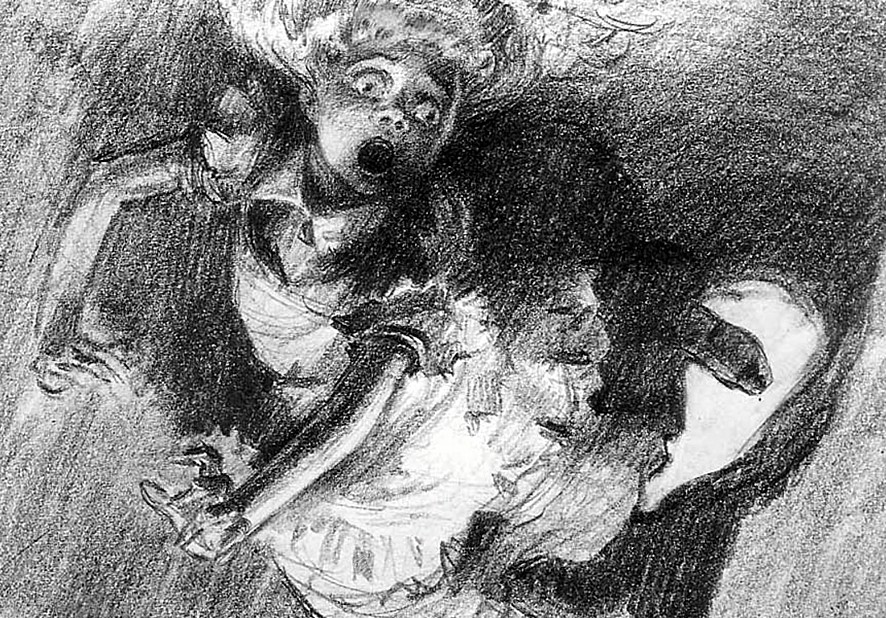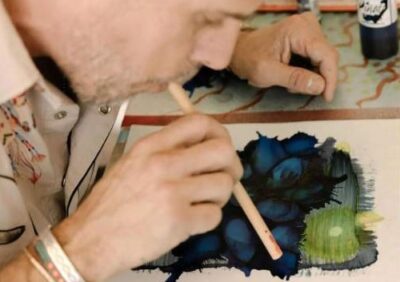A Simulacrum Looking-Glass World
On Sept, 27, 2021, “the Big Guy” was speaking at the White House about his Covid-19 vaccination efforts. However, the real focus of the event was his receiving a third mRNA Covid vaccine shot live on camera. You undoubtedly saw photos of the black-masked Biden sitting in the White House with his sleeve rolled up, a nurse giving him the inoculation. But nothing is quite as it seems in the Looking-Glass world.
Mainstream news broadcasts aired a brief snippet of film showing Biden in the White House being vaccinated. Still photos of the event were published by online corporate news sources. Those photos circulated on the internet and people began to notice some oddities.
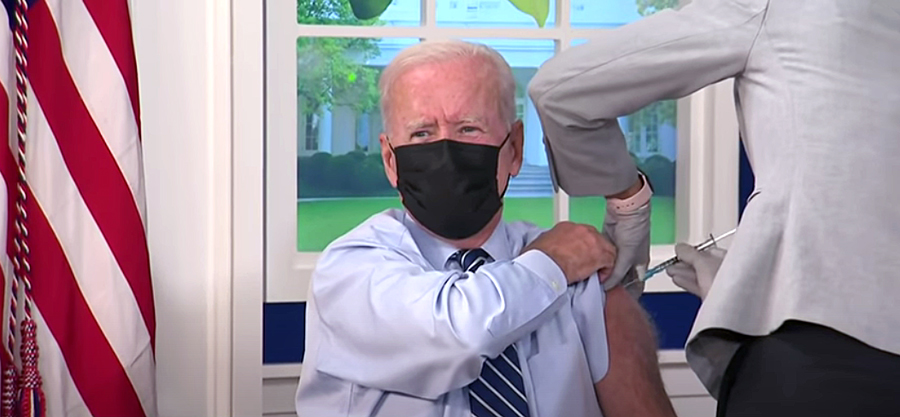
While it was reported that Biden was inoculated at the White House, viewers noted that from the windows of the room where he was vaccinated, one could see the White House. People began to wonder, “where was this filmed?” The event took on the aura of Alice’s Adventures in Wonderland when observers noted the tree boughs and branchlets outside of the windowed room didn’t move in the breeze. Some said it was a giveaway that out of three windows, two suns blazed above the executive mansion, or so it appeared.

A day later other photos began to circulate, and down the rabbit hole we all tumbled. Like an exploded-view drawing, the photos showed various characters and props. At center stage sat Scranton Joe and his trusted doctor, together they were surrounded by the trappings of power—Presidential Seal, US Flag, a peek at the White House outside the fake windows. Off-stage, journalists silently sat in the dark, documenting the performance to present a Potemkin on the Potomac to the unsuspecting. Curiouser and curiouser!
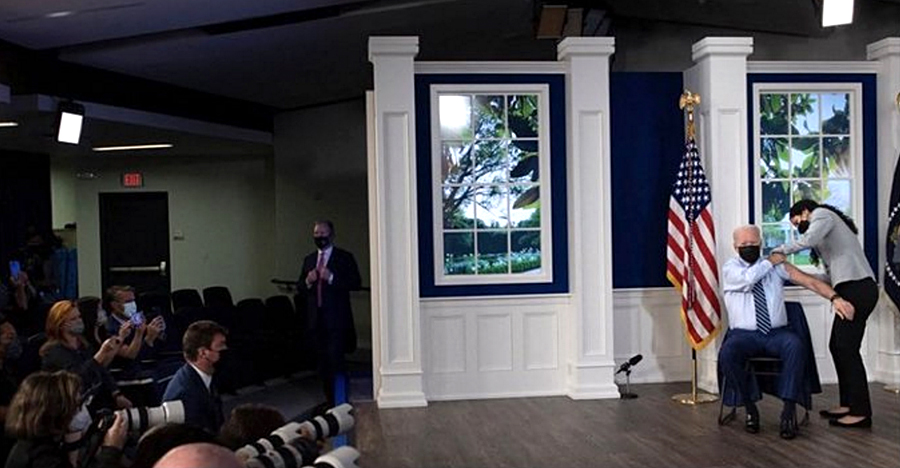
Many suspected the photographs were “doctored images,” but video of the event appeared online. The Los Angeles Times and CBS News are but two of the corporate media entities that published video. The rumor mill blazed and churned. Biden was not in the White House, he was on a stage! It was a phony White House room constructed for the occasion! The motionless tree branches were fake, what else was a sham? It was all theatrics, a mock nurse vaccinating a pretend president! The rumbling continues, and for good reason—there are seeds of truth in the rumoring.
For reasons unknown, Biden did not hold his publicity stunt vaccination in the White House. It was conducted at the South Court Auditorium of the Eisenhower Executive Office Building (EEOB), just west of the White House. In video of the event, when Biden ended his pro-vaccine speech, he introduced “the Major,” a “nurse with the White House Medical Unit” (according to the administration), who administered the vaccination.
But why not hold the vaccination event in the Oval Office, the president’s formal workspace? You cannot say it is less sanitary than the stage in the Eisenhower Executive Office Building. Why not have the official physician to the president, Dr. Kevin O’Connor, administer the vaccination instead of an anonymous nurse? These two things would have conferred gravitas to the event. A small press pool could have provided photos and accounts to the national and international media.
The Eisenhower Executive Office Building houses the majority of offices for White House staff, and its South Court Auditorium has in the past hosted events by President Obama and President Trump. Photos of these events can be found on the Alamy Stock Photo agency, where I also confirmed that Biden used the EEOB auditorium for his Sept, 27, 2021 televised vaccination.
The EEOB auditorium has a stage with interchangeable backdrops, walls, and digital displays. The three windowed backdrop with artificial views of the White House has been seen at other Biden events in the auditorium. Backstage is situated behind the backdrop. The ceiling is equipped with track lighting that uses square LED lighting panels.
During the Biden inoculation, light from two backstage fixtures can be seen through the semi-opaque images framed in the fake windows; hence the confusion over two suns. The stage, facing seats for approximately 200, is only slightly elevated above the floor. The day of the Biden jab, press photographers with telephoto lenses crammed the seating area.
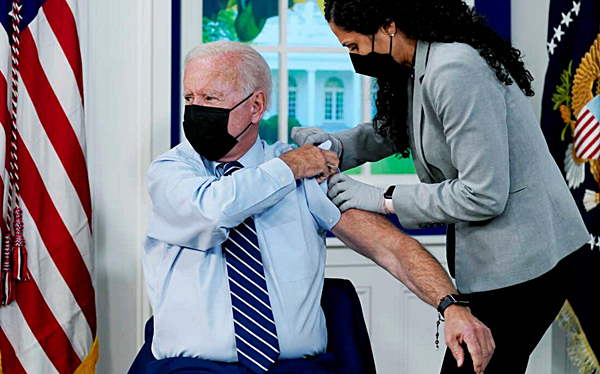
What did Biden gain by holding his publicity stunt at the Eisenhower Executive Office Building? As an event meant to attract attention and sway public opinion, it was about as successful as his withdrawal from Afghanistan.
The EEOB affair was so ineffectual that it left in its wake doubt and rumors of skulduggery. Marketers, celebrities, politicians, and others have used stunts as a way to garner publicity, likewise, propagandistic communication manipulates the attitudes of targeted audiences. Regardless, Lunchbox Joe’s communications team proved unskilled on both counts… but it was not for lack of trying.
Joe’s stagecraft or lack thereof, was not the inspiration for this essay, I give Lewis Carroll’s 1865 classic Alice’s Adventures in Wonderland credit for that. Watching the televised inoculation I thought of the Cheshire Cat’s words, “we’re all mad here.” That a stage production replete with props can be taken for reality reminded me of the cliché some use to describe real world events—“It was just like a movie!” We have slid into the madness of postmodern culture.
Well trained moderns are not able to discern the real from a simulation, but hey, artificiality is as good, if not better, than the real thing. Or so it is said. Simulacra replacing reality is found everywhere; think of Auto-Tune displacing the human voice in pop music, or CGI Cinematography superseding our understanding of color, depth perception and perspective. Mobile phones and laptops give you nothing but simulacra. The art world has glommed onto “appropriation art” and other postmodern tragedies. What passes for journalism is now little more than pre-packaged falsehoods. Heck, even the doings of politicians have become vague semblances of action; Biden’s imitation White House for example.
As an artist I always appreciated the late 1950s French artist’s group, the Situationist International (SI). They described our social order as the “spectacle commodity” society; a daily parade of consumerist culture, not a reflection of the real world—but a media spectacle we are conditioned to favor through an endless stream of manufactured events and desirable commodities.
Situationists thought the ruling class culture machine intentionally reduced everything to simulacrum, in part because representing the real with symbols gave ultimate power to those who produced the ideograms. Ruling clique media was not for imparting information, it was for interpreting our private selves and selling our desires back to us. Simulacrum became a method of social control, certainly this is what today’s Tech-Lords have done with Twitter, Facebook, YouTube, and Tik Tok. The only thing that changed in the interim was the packaging.
Jean Baudrillard, the French cultural theorist associated with the SI, once said: “It is no longer a question of imitation, nor duplication, nor even parody. It is a question of substituting the signs of the real, for the real.”
Today’s postmoderns give credit to the Situationists for inaugurating performance art, conceptual art, and installation art, which is nonsense of course. Postmodern art is just an updated app in the ruling class culture machine. If the SI were active today (they disbanded in 1972), they would go after the art establishment with hammer and tongs.
Here is another example of our willing acceptance of artificiality. In 1962 the Louvre in Paris loaned Leonardo da Vinci’s Mona Lisa to US museums for exhibit. When informed the painting was coming to America, Andy Warhol quipped, “Why don’t they have someone copy it and send the copy, no one would know the difference.” And they call that guy a genius. Things have only gotten worse—today Non Fungible Tokens are a big thing for the so-called “art market.”
If the French neo-Marxists of the Situationist International are not your cup of tea, then read the words of Václav Havel (1936-2011), which could have been written yesterday. Havel was a Czech playwright, poet, and opponent of Soviet rule over his nation. When communism collapsed in Czechoslovakia in 1989, Havel was elected president. In 1993, when Czechoslovakia split into the Czech Republic and the nation state of Slovakia, Havel became the Czech president.
Havel was forced into the role of dissident when, during the 1970s and ‘80s, the communist regime censored and banned his plays, confiscated his passport, and repeatedly arrested him. The Stalinist government put him in prison for four years. Havel’s words from those dark days have an unnerving familiarity to them:
“Life in the system is so thoroughly permeated with hypocrisy and lies, because the regime is captive to its own lies, it must falsify everything. It falsifies the past. It falsifies the present, and it falsifies the future. It falsifies statistics.”
The realities expressed in the above paragraph loom large in Havel’s works; Americans concerned with totalitarianism should read his satirical writings. His 1965 The Memorandum tells the tale of a large office where bureaucrats saddle the employees with Ptydepe—an ungraspable pseudo language designed, presumably, to increase communication and productivity. Everyone is ordered to speak the language, but no one knows how. Rifts open up in the workforce and productivity goes down.
Bureaucrats provide a classroom to teach Ptydepe, but it is much too difficult to learn. Mayhem reigns until the workplace officials manufacture the solution… a different artificial language called Chorukor is mandated.
In closing, just keep in mind that the totalitarian stranglehold that plagued and tortured the people of Czechoslovakia, was swept away in 1989 by the non-violent “Velvet Revolution.” With smiles on their faces and poems in their hearts, the love, solidarity, and national unity of the people defeated the tyrannizers.
My final words offer cautionary advice about gulping down the toxic lies you are offered everyday. The admonition actually comes from Lewis Carroll’s Alice. The sweet child said: “If you drink much from a bottle marked ‘poison’ it is certain to disagree with you sooner or later.”



